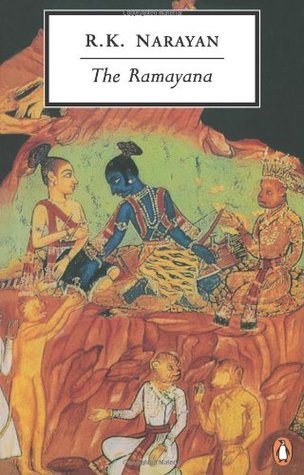The Ramayana

Rating: 4.5/5
Author: R.K. Narayan
Publisher: Chatto and Windus
Publishing Date: 1972
Language: English
Genre: Mythology
ISBN-10: 0143039679
ISBN-13: 978-0143039679
Format: Paperback
Pages: 192
Plot:
A sweeping tale of abduction, battle, and courtship played out in a universe of deities and demons, The Ramayana is familiar to virtually every Indian. Although, the Sanskrit original was composed by Valmiki around the fourth century BC, poets have produced countless versions in different languages.
Here, drawing on the work of an eleventh-century poet called Kamban, Narayan employs the skills of a master novelist to re-create the excitement he found in the original. A luminous saga made accessible to new generations of readers, The Ramayana can be enjoyed for its spiritual wisdom, or as a thrilling tale of ancient conflict.
Review:
Narayan’s version of Ramayana is the crisp and simple version of the epic saga of Hindu Mythology. As the back cover points out, ‘The Ramayana’ is, quite simply, the greatest of Indian epics’. It was first put in writing between 1500 and the fourth century B.C., but it has been adapted and retold many times, each storyteller offering a slightly different version in the intent to accommodate the tale to one’s demands and preferences. This version, told by R.K. Narayan, is based on the Tamil version written by Kamban.
The Ramayana tells the story of Rama, a man who is an avatar (incarnation) of the Hindu god Vishnu. As such, Rama possesses all of Vishnu's godly qualities in the body of a man, and is therefore meant to represent an image of the ideal man according to Hindu philosophy. On a very basic level, the Ramayana is a simple tale of good triumphing over evil.
The two ideologies or morals that follows almost every character are- Honour and loyalty. Even though honouring one's promises and behaving loyally often has disastrous short-term consequences for the characters, they overwhelmingly choose to follow through with their promises, which later result in long-term success.
Another striking difference in Narayan’s version reflects a deeper analysis of the character of Rama. Narayan believes that Ram was wrong to indeed let Sita undertake the ‘Agnipariksha’. The original epic poem consists of 24,000 verses and 500 chapters, while Narayan’s version consists of a mere 150 pages and 14 chapters.
About the Author:
R. K. Narayan was born in Madras, South India, and educated there and at Maharaja’s College in Mysore. His first novel Swami and Friends (1935) and its successor The Bachelor of Arts (1937) are both set in the enchanting fictional territory of Malgudi. Other ‘Malgudi’ novels are The Dark Room (1938), The English Teacher (1945), Mr. Sampath (1949), The Financial Expert (1952), The Man Eater of Malgudi (1961), The Vendor of Sweets (1967), The Painter of Signs (1977), A Tiger for Malgudi (1983), and Talkative Man (1986). His novel The Guide (1958) won him the National Prize of the Indian Literary Academy, his country’s highest literary honour. He was awarded in 1980 the A.C. Benson Medal by the Royal Society of Literature and in 1981 he was made an Honorary Member of the American Academy and Institute of Arts and Letters. As well as five collections of short stories, A Horse and Two Goats, An Astrologer’s Day and Other Stories, Lawley Road, Under the Banyan Tree and Malgudi Days, he has published a travel book, The Emerald Route, three collections of essays, A Writer’s Nightmare, Next Sunday and Reluctant Guru, three books on the Indian epics, and a volume of memoirs, My Days.















































